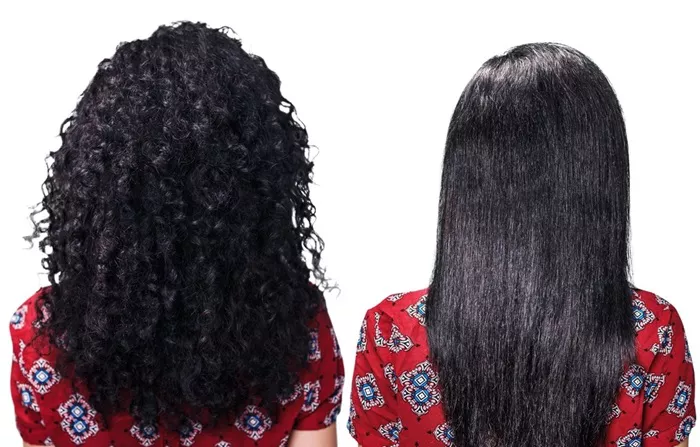Curly hair can be beautiful, but many people want to switch to straight styles for variety or manageability. As a hairstylist with years of experience, I’ll explain safe and effective methods to transform curls into sleek strands. This guide covers both temporary and permanent solutions.
Understanding Your Hair Type First
Before straightening, know your curl pattern and hair health. Curly hair ranges from loose waves (Type 2) to tight coils (Type 4). Thicker, coarser hair often requires more heat or stronger products. Always check for:
- Split ends
- Dryness
- Previous chemical treatments
Damaged hair needs extra care to avoid breakage during straightening.
Heat Styling Tools for Temporary Results
Flat irons and blow dryers are the quickest ways to get straight hair. Follow these steps:
Prep with Heat Protectant
Apply a heat protectant spray evenly. This creates a barrier against high temperatures.
Dry Hair Completely
Use a blow dryer with a concentrator nozzle. Point the airflow downward to smooth cuticles.
Section and Straighten
Divide hair into 4-6 sections. Use a ceramic flat iron (350°F-400°F for thick hair, 300°F-350°F for fine hair). Glide the iron slowly from roots to ends.
Pro Tip: For extra shine, rub a drop of argan oil between palms and smooth over styled hair.
Chemical Straightening for Long-Lasting Effects
Chemical treatments alter hair structure for 3-6 months of straight hair. Popular options include:
Keratin Treatment
- Fills gaps in hair with protein
- Reduces frizz by 60-80%
- Lasts 2-4 months
- Uses formaldehyde-free formulas (safer option)
Japanese Straightening
- Permanently breaks hair bonds
- Results last until new growth appears
- Not recommended for color-treated hair
Warning: Always do a strand test 48 hours before full application to check for allergies.
Blowout Techniques Without Chemicals
A professional blowout can keep hair straight for 5-7 days with proper care:
- Wash with smoothing shampoo
- Apply anti-frizz serum
- Use a round brush while blow-drying:Hold brush at 45° angle,Tension-dry sections from roots to ends
- Finish with cold air to seal cuticles
Night Care: Wrap hair in silk scarf to maintain straightness.
Temporary Straightening Products
For short-term styling, try these rinse-out options:
Straightening Creams: These products coat hair strands to resist humidity and relax curls. Ideal for wavy to curly hair (Type 2–3), they work best when applied to damp hair and blow-dried straight.
Styling Gels: Thick gels weigh down curls, creating a smoother texture. Use sparingly on short hair to avoid stiffness.
Hair Wax: Perfect for thick, unruly curls, wax provides strong hold and reduces volume. Warm a small amount between palms before applying.
Apply products evenly and comb through hair before air-drying or using a blow dryer.
Natural Alternatives to Relax Curls
If you prefer chemical-free methods, try these DIY approaches:
Coconut Milk and Honey Mask
Mix ½ cup coconut milk with 1 tablespoon honey. Apply to damp hair, leave for 45 minutes, then rinse. The proteins in coconut milk temporarily soften curls.
Overnight Oil Treatments
Massage warmed olive oil or castor oil into hair, focusing on the ends. Cover with a shower cap and rinse in the morning. Heavy oils stretch curls by adding weight.
Tension Drying
After washing, stretch sections of damp hair with your fingers and secure them close to the scalp with clips. Let hair air-dry or use a diffuser on low heat.
Post-Straightening Hair Care
Maintaining straight hair requires diligent care to prevent damage:
Wash Less Frequently: Overwashing strips natural oils. Aim for every 3–4 days using a sulfate-free shampoo.
Hydrate Regularly: Apply a deep conditioner weekly to replenish moisture.
Protect at Night: Sleep on silk pillowcases to minimize friction and frizz.
Trim Split Ends: Schedule trims every 8 weeks to keep hair healthy.
Avoid Heat Overload: Limit flat iron use to 1–2 times weekly.
Avoid These Habits:
- Tight ponytails that stress hair
- Swimming without a silicone-coated swim cap
- Skipping heat protectant
Troubleshooting Common Issues
Even with careful styling, problems can arise. Here’s how to fix them:
Curls Reverting: Spritz roots with dry shampoo to absorb moisture and add texture.
Frizz Breakthrough: Rub a pea-sized amount of hand cream between palms and smooth over flyaways.
Flat or Lifeless Hair: Gently backcomb roots with a fine-tooth comb for volume.
Restore protein with a DIY mask—mix 1 egg and 2 tablespoons plain yogurt, apply for 20 minutes, then rinse.
When to Consult a Professional
Visit a salon if:
- Your hair feels mushy or overly stretchy (a sign of severe damage).
- You want chemical treatments like keratin or Japanese straightening.
- Home methods cause excessive breakage or uneven results.
- You have multiple curl patterns (e.g., straight roots with curly ends).
Professionals use high-quality products and advanced techniques to minimize risks.
Conclusion
Straightening curly hair can be done safely with the right approach. Temporary methods like heat styling or blowouts offer flexibility, while chemical treatments provide longer-lasting results. Always prioritize hair health by using heat protectants, maintaining moisture, and avoiding over-processing. For major transformations, consult a licensed stylist to achieve your desired look without compromising your hair’s integrity. With proper care, you can enjoy the best of both worlds—sleek straight styles and healthy, resilient curls.
Related topics:
How To Straighten Curly Hair Naturally
How To Chemically Straighten Curly Hair
How To Straighten Curly Hair Without Frizz


